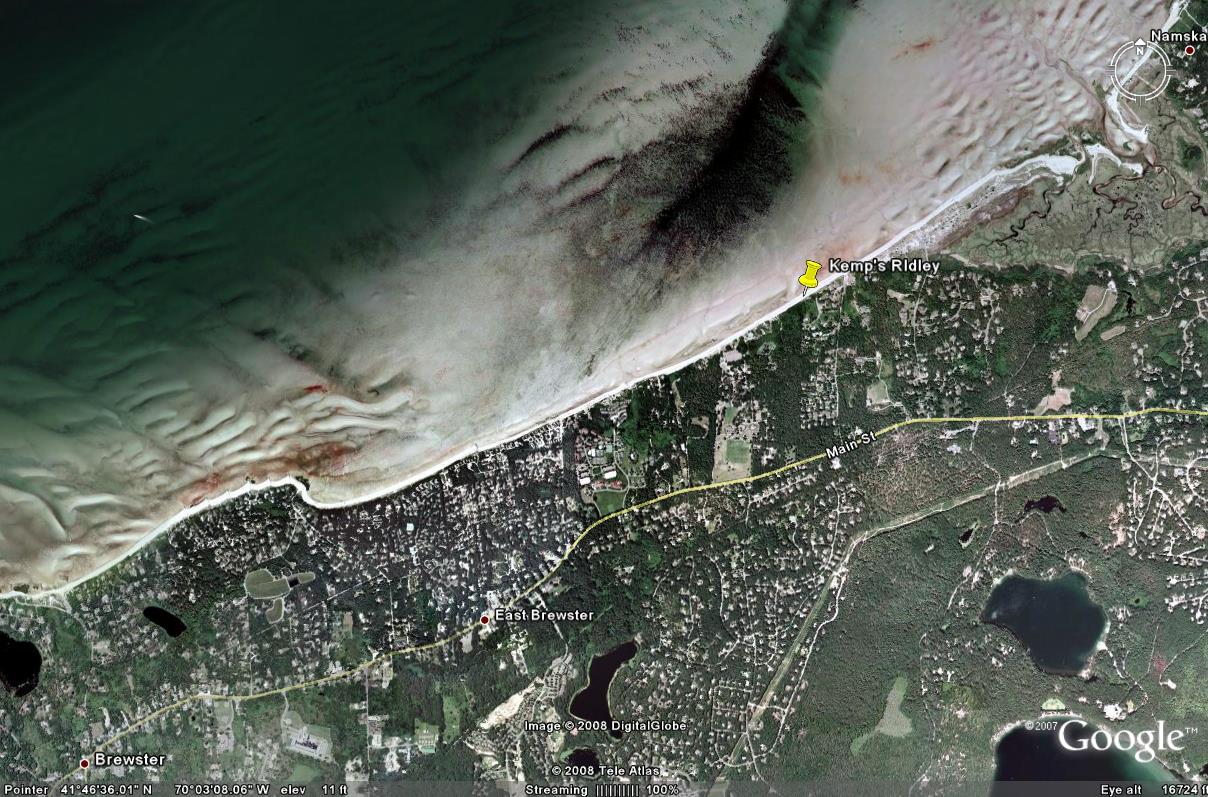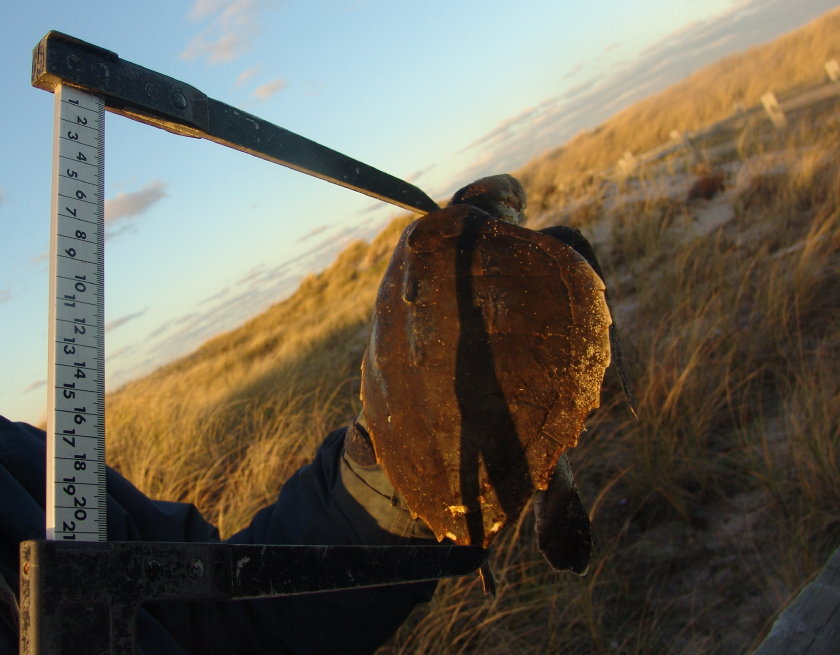Kemp’s Ridley Sea Turtle @ Linnell Landing, Brewster
She may not have been the smallest Kemp’s ridley sea turtle we’ve ever rescued from Cape Cod Bay. Don seems to remember a 1200-gram ridley from early in the 1999 mass standing season. But at 8.5 inches straight-line length (nuchal to notch) and 1470 grams mass, this seriously cold-stunned sea turtle surely fell in the lowest 1 percentile size class. With that size and the razor sharp points along her vertebral keel, we assessed her as a very young ridley. She proved a great find for the Turtle Journal team as we patrolled Brewster (Cape Cod) beaches on Wednesday afternoon.
(ASIDE:Â No, we don’t know that this turtle is a female, but we can be hopeful and “she” reads better than “it.”)
Brewster Coastline from Breakwater (left) to Crosby (right)
Howling winds persisted on the Cape, shifting to north-northwest at 25 to 30 knots. Temperatures had dropped so fast that moisture had rapidily precipitated from super chilled clouds, producing our first snowfall of the season. Perfect sea turtle stranding conditions on Cape Cod! As we described previously (Leapfrogging Sea Turtle Patrol Yields Surprise), the wind vector indicated a center point for the stranding search along the northeast-facing Brewster coastline. We decided to begin our patrol at Breakwater Beach (left edge of Google photo) and leapfrog to Point of Rocks, Ellis, Linnell and end at Crosby Beach (right of photo), a little over three miles to the east. The trick to survive these brutal conditions (for the two-legged mammals, that is) is to keep the wind at your back or over your shoulder as you search the beach.
Tiny Kemp’s Ridley Tossed on the Beach by a Rising Tide
The sun flashed in and out of clouds as wind flung them across the sky as easily as the crashing waves tossed debris on the beach. Aided by the blow, the rising tide forced us to dance across seawalls and zigzag through sand fencing as we were pinned to the dunes by breakers. And, yes, we did get a bit wet, mostly from spray but also when we were trapped by a few overly aggressive waves.
With nothing to show for 2.9 miles of the 3 mile trek, we were torn between elation to get back in the warm car and disappointment in not finding a cold-stunned turtle to rescue. But those feelings turned around in an adrenaline rush as Don spotted a dark oval shape thrown onto the white foamy beach about a 100 yards ahead. It had all the right characteristics of shape and color, but it was awfully small. Waves began to circle and retrieve the object in the rising tide, so he sprinted and caught the turtle as water started to drag it back into the surf.
Click Here to View Video in High Quality
Kemp’s Ridley Beach Rescue and Field Assessment
Kemp’s ridleys are critically endangered sea turtles. Each fall a large number of juvenile ridleys in the two to four year age cohorts get trapped in hook of Cape Cod by fall’s dropping temperatures and become cold-stunned in the bay. Once water temperature drops below 50 degrees, they become helpless and are at the mercy of wind and tides for movement. Eventually, the prevailing autumn westerly gales blow these turtles onto a high tide beach along the inner, bayside beaches. The earlier in the season those strandings occur, the higher the percentage of animals that we can save. This year has been calm and mild, delaying the stranding and jeopardizing turtle lives. But that all changed the last few days, and especially on Wednesday.
Measuring 8.5 Inches and Weighing 1470 Grams
Once at the car, we did a quick field assessment. The first procedure to check is whether you can get a reaction from the animal to indicate that it is still alive. One thing that we have learned through the decades of cold-stunned rescues is that it is nearly impossible to determine for sure … absent rigor mortis … whether a sea turtle, beating its heart once a minute, is alive or dead. But it helps to know for sure that you have a live animal, at least for the human spirit, anyway. This little turtle was not in rigor, and showed some eyelid reaction and muscle movement in the front flippers.
Cold-Stunned Kemp’s Ridley with Algae Buildup on Plastron
You can see from the plastron (bottom/ventral surface) that algae has accumulated during the turtle’s period of stupor. Also, the reddish skin near the posterior flippers indicates blood pooling from reduced circulatory flow while its heart rate has been so slow.
Click Here to View Video in High Quality
First Stop to Recovery: Wellfleet Bay Wildlife Sanctuary
First stop on her journey to recovery is Mass Audubon’s Wellfleet Bay Wildlife Sanctuary, turtle rescue central on Cape Cod. The turtle will undergo triage at the sanctuary and will be stabilized in a “cold room” while transport is arranged to Boston. At the New England Aquarium, the turtle will receive emergency medical care and will undergo rehabilitation. The reason for the “cold room” is that these animals must not be allowed to warm up too quickly.  Protocol calls for about five degrees a day. That’s why, once we have rescued a sea turtle from the beach, we turn off the heat in our cars, crack the windows and shiver all the way to the sanctuary.Â
Kemp’s Ridley Rescue from Linnell Landing
Sea turtle patrols will continue so long as the winds sustain. Twice a day, at each high tide, a small army of layered and bundled volunteers will patrol beaches in search of cold-stunned sea turtles. If they are as lucky as the Turtle Journal team was on Wednesday, they too will return to their cars with a precious handful of life.






[…] about half a mile to go to reach our pre-positioned car at Winslow Landing. (You may recall from Tiny Kemp’s Ridley Rescued in Freezing Conditions that we try to plan these patrols so that we are always walking with out back to the wind. It […]
[…] The Turtle Journal story about this particular Kemp’s ridley rescue ran as Tiny Kemp’s Ridley Rescued in Freezing Conditions. […]
KUDOS, I am impressed and humbled at what you do for these Sea Turtles, I had no idea they traveled so far north.
I live in the Mojave Desert and our Tortoises suffer also, due to natural predators and traffic.
Keep up the excellant work.
Marijane Dennis
Thank you for saving the turtles!!!
Larry Sanford, fellow turtle lover
http://www.glolar.com/turtlescreensavers.htm
I read an article today in US Today about the sea turtles washing up on shore in the cold condidtions and freezing to death. It referenced your website (www.turtlejournals.com). I think what you are doing is absoluetly wonderful. If I lived in your area, I would be out there helping. Bless your heart for caring!
Janel
Alma, Michigan
I, too, saw the article in USA Today about the sea turtles. Thanks for what you do. I forwarded the article to my grandson who loves turtles to further spark his interest and education. Thank you for all you do!
Mary
Salt Lake City, UT
I read in USATODAY of your work to help turtles and was so greatly moved. My Husband had earlier read the article and silently watched as I read the story by Emily Bazar. When I got to the last lines, a quote actually from Don Lewis, I almost sobbed outloud it was so moving. My Husband said: “I knew you’d be touched by that man’s words and feelings…”
I hope this one message encourages you to invite an author and illustrator to record your work in a childrens book. Include that scene of Mr. Lewis as the closing moment – it will do far more than anything you can imagine. Children are to hope of tomorrow — and the promise of understanding the plight of the worlds natural treasures.
I wish you all the best — from Audrey in Arkansas
If I lived in your area I sure would be helping. I am proud of people like you that reach out and help. We need more people to understand the balance of nature and how we need to help the environment. Right now I am watching Animal Planet”Blue Planet Seas OF Life. The photography is amazing.
I also have the wonderful oppertunity to live in a national park and I get to enjoy all the wonderful flora and fauna. So great to be close to nature in the raw.
D.Shafer BBNP TX
Thank you for taking care of the turtles!